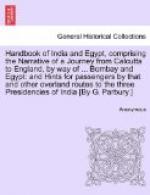Turn off the main thoroughfare and you may perhaps find a lean Musalman, with a green silk skullcap, sitting in a raised and well-lighted recess in front of an urn in which frankincense is burning. He has taken a vow to be a “Dula” or bridegroom during the Mohurrum. There he sits craning his neck over the smoke from the urn and swaying from side to side, while at intervals three companions who squat beside him give vent to a cry of “Bara Imam ki dosti yaro din” (cry “din” for the friendship of the twelve Imams). Then on a sudden the friends rise and bind on to the Dula’s chest a pole surmounted with the holy hand, place in his hand a brush of peacock’s feathers and lead him thus bound and ornamented out into the highway. Almost on the threshold of his passage a stout Punjabi Musulman comes forward to consult him. “Away, away” cry the friends “Naya jhar hai” (this is a new tree), meaning thereby that the man is a new spirit-house and has never before been possessed. A little further on the procession, which has now swelled to considerable size, is stopped by a Mahomedan from Ahmednagar who seeks relief. He places his hand upon the Dula’s shoulder and asks for a sign. “Repeat the creed,” mutters the ecstatic bridegroom. “Repeat the durud,” say the Dula’s supporters; and all present commence to repeat the “Kalmah” or creed and the “Durud” or blessing. Then turning to the Mahomedan who stopped him, the bridegroom of Husein cries: “Sheikh Muhammad, thou art possessed by a jinn—come to my shrine on Thursday next,” and with these words sets forth again upon his wanderings. Further down the Bhendi Bazaar a Deccan Mhar woman comes forward for enlightenment, and the Dula, after repeating the Kalmah, promises that she will become a mother before the year expires;




